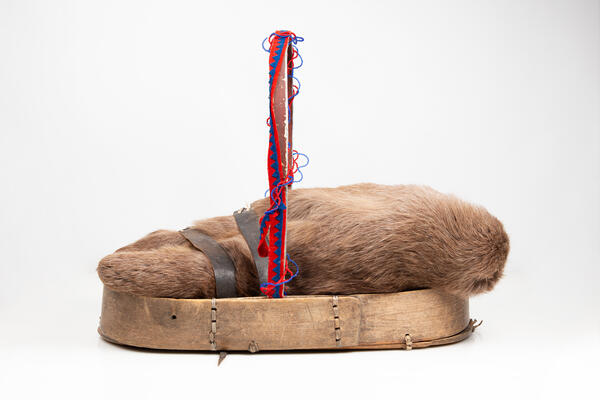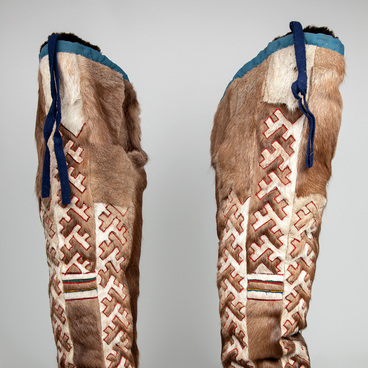The birth of children has always been an important event for the Forest Nenets, who lived in harsh natural conditions. It was customary for them to celebrate their birthday only once in their lives, on the day the baby was born. It was a day of great joy for parents and relatives: “In the old days, on such an occasion, a shaman was invited to initiate the child into the human world and protect it from evil spirits.” When a boy was born, a young deer was slaughtered. The guests brought expensive gifts: cuts of calico or cloth so that the mother could sew a cover for the cradle, warm diapers made of deer beard, birch bark pieces for the cradle, matches, a bag with food — a piece of deer fat, bread and sugar. Rich relatives, as well as mother and father, gave the newborn a young deer.
Children spent their first year of life in the cradle. They slept and were awake there, transported on a sled and in a boat during relocations. Regardless of the number of children, there was only one cradle in a Nenets family; it was made for the birth of the first child and passed on to each next child until it wore out. Each nation has developed its own traditions of making a baby cradle, and the design of the Nenets cradle is still in use. It has an oval shape and a flat bottom, in ancient times it was made of birch or pine and fastened with leather strips, and with the advent of modern materials, the Nenets began to use sheet plywood.
There are holes in the side of the cradle through which ropes or leather straps are passed to secure the child. In the bottom, from the side of the baby’s legs, there is a special ledge, to which a rope is tied to swing the cradle, and loops are made on the sides for hanging the cradle from the pole of the chum (a Nenets dwelling) — similar to the Russian cradle. On top of the cradle, there is an arc for fastening the canopy, which protects the baby from snow, wind and insects. Before the advent of modern baby care products, a soft skin of a young deer, sewn in an envelope, was laid in the cradle, and a special birch bark tray was placed above the baby’s legs to protect the blanket from getting wet. The Nenets have long used colored cloth, metal rings, wooden amulets and beads to decorate a baby’s cradle. The cradle was one of the main objects of the house and was valued as a work of art.
Children spent their first year of life in the cradle. They slept and were awake there, transported on a sled and in a boat during relocations. Regardless of the number of children, there was only one cradle in a Nenets family; it was made for the birth of the first child and passed on to each next child until it wore out. Each nation has developed its own traditions of making a baby cradle, and the design of the Nenets cradle is still in use. It has an oval shape and a flat bottom, in ancient times it was made of birch or pine and fastened with leather strips, and with the advent of modern materials, the Nenets began to use sheet plywood.
There are holes in the side of the cradle through which ropes or leather straps are passed to secure the child. In the bottom, from the side of the baby’s legs, there is a special ledge, to which a rope is tied to swing the cradle, and loops are made on the sides for hanging the cradle from the pole of the chum (a Nenets dwelling) — similar to the Russian cradle. On top of the cradle, there is an arc for fastening the canopy, which protects the baby from snow, wind and insects. Before the advent of modern baby care products, a soft skin of a young deer, sewn in an envelope, was laid in the cradle, and a special birch bark tray was placed above the baby’s legs to protect the blanket from getting wet. The Nenets have long used colored cloth, metal rings, wooden amulets and beads to decorate a baby’s cradle. The cradle was one of the main objects of the house and was valued as a work of art.




